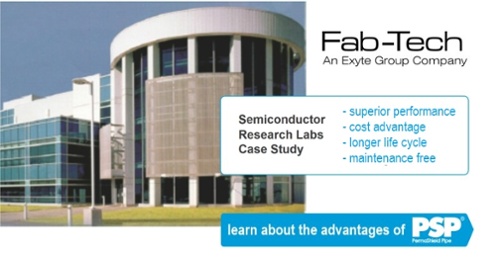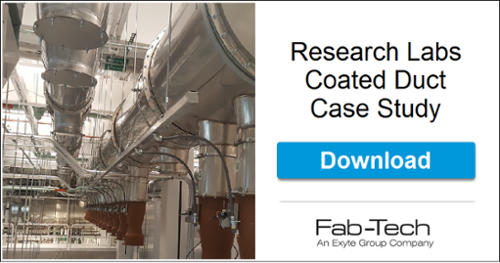5 Fundamentals For Dynamic Lab Air Quality Needs
 In the face of exponentially changing technology and consumer demands, advanced manufacturing industries are driving research labs and clean rooms to accommodate multiple production flows.
In the face of exponentially changing technology and consumer demands, advanced manufacturing industries are driving research labs and clean rooms to accommodate multiple production flows.
As such, these facilities must contend with a wider spectrum of lab air quality requirements, including increased air supply, dynamic airflow patterns, room pressurization, and high-efficiency air filtration versus that of traditional labs and clean rooms.
Here we'll cover 5 fundamental lab air quality considerations that should be factored into every advanced manufacturing clean room or research lab design.
1) Basis of Design (BOD)
When designing a multi-use clean room or research lab, the Basis of Design (BOD) first needs to be created according to the manufacturing processes occurring within the facility. The BOD should outline area cleanliness, product requirements, and the desired occupant comfort, which will help define the temperature, humidity, and pressurization for each process area.
Most importantly, the cleanliness standards (ISO) necessary for each process should be determined and carefully paired with the above considerations. ISO standards are typically classified in terms of the number of particles per cubic foot of air found within a clean room space.
/open%20and%20flexible%20clean%20room%20design%20with%20raised%20access%20flooring.png?width=600&height=450&name=open%20and%20flexible%20clean%20room%20design%20with%20raised%20access%20flooring.png)
2) Lab Air Segregation, Containment, and Flow
Facilities with more than one high-purity lab or clean room should possess separate Air Handling Units (AHU) for each space. An AHU is simply where the air is filtered and heated or cooled. Cooling coils, chilled water coils, hot water or electric heating coils, and humidifiers comprise the AHU. Each AHU will service a separate HVAC system with its own air conditioning devices, air distribution ducts, supply, return, exhaust fans, and automated control systems.
Depending on the activities and materials within each area, the AHU will be designed to either recirculate air or use it once. Recirculated air systems are frequently used for common work areas or offices spaces, whereas production labs and clean rooms are more likely to require laminar airflow and once-through AHUs.
Next, the amount of Air Changes per Hour (ACH) needs to be determined. This rate of airflow is critical and takes into account multiple factors which should be understood by facility owners and their clean room engineers to determine preferred ACH. These factors include:
- Required ISO levels for each process to withhold its integrity
- Number of people working in the space: 70-80% of clean room contamination is produced by the workers in that space (3)
- Size and number of rooms within the clean room
- Equipment, supplies, and appliances within the area that will generate contamination
- Heat gain
- Movement of people and material in and out of the space
3) Safe and Dependable Exhaust Equipment
Clean room and research lab exhaust equipment is important not only for the safety of lab technicians, but for the larger facility and its general occupants as well.
Exhaust systems typically begin with an enclosure, like a fume hood, which expels contaminants and corrosives from the building via specialty exhaust duct. While the specifics of each exhaust system depends on the process and substances that are to be used in the space, the exhaust duct itself should be engineered to be completely safe and dependable throughout; even when the exhaust fans are not running.
This means using materials that:
- prevent particles and vapors from being trapped anywhere in the system (completely smooth surfaces),
- are low-emitting and prevent leakage via superior coatings and joint technology,
- are low maintenance and can stand up to harsh chemical, weather, and UV combinations,
- are true Class 1 duct with zero flame-spread and ≤ 20 smoke generation ASTM E-84 ratings.
In dynamic, or multi-use lab design, it can be good practice to employ a worst-case design strategy. This approach assumes that the work spaces will eventually need to vent a wide variety of toxic, chemically hazardous and/or corrosive materials. Since air supply is only one part of the air flow equation, designing for the most caustic and hazardous fume exhaust needs will help to ensure that the lab space is truly capable of handling multiple research initiatives.
Such measures might include utilizing a once-through system that is vented with fluoropolymer coated stainless steel fume exhaust duct. PSP® coated stainless steel duct is designed to handle everything from general exhaust ventilation to toxic and even corrosive fumes and vapors. In addition to creating a safe, capable, and long-lasting work environment, this makes for simpler, easier, and less disruptive transitions if the use of that space changes in the future.
4) Pressurization
Pressurization and air locking must also be factored during the design process. This is done to ensure that contaminated air does not seep into spaces where it isn’t wanted. There are three main air lock designs that can protect clean rooms from cross-contamination between different process-oriented systems.
- Cascading Pressure Air Lock: Used to protect clean rooms from bordering process areas with lower cleanliness standards. The transfer air from the cleaner area is pushed into the access hallway between the two adjoining process spaces.
- Pressure Bubble: This airlock creates a barrier between the clean room and the access area or bordering space. The clean room is positively pressurized, which forces the airflow out and away into the bordering spaces, keeping the clean room air uncontaminated.
- Pressure Sink: This airlock also creates a barrier between the clean room and access area or bordering space. The space between the clean room and the neighboring area is negatively pressurized, pulling air from both spaces and preventing contamination between spaces.
5) Temperature and Humidity
/Clean%20Room%20Standards%20in%20Practice.png?width=300&name=Clean%20Room%20Standards%20in%20Practice.png)
While this can be easy to overlook, it is important to maintain control over the temperature and humidity of every space and "zone" them accordingly.
In order to keep the facility's manufacturing capability adaptable, each critical process area needs individualized temperature management capabilities.
Placing reheat coils on the supply duct and locating thermostats in each room gives each area the ability to control its temperature.
Similar to temperature, Relative Humidity (RH) of the spaces must be controlled at each AHU. If the RH is too low, then personnel-particle-shedding is increased, thus contaminating the space. If the RH is too high, then toxic molds and bacteria could grow. Likewise, the added moisture might saturate the hygroscopic powder that's typically found within clean rooms to create buffers.
Here are some best practices for controlling the RH in each area serviced by an AHU:
Humidification: Use a clean steam humidifier installed at the AHU to preserve the set humidity level within the spaces that the AHU services. In spaces where a product or process requires a specific RH, then the humidifier should be mounted on the supply-duct serving only that space.
Dehumidification: Taking moisture away from the supply air can be done via the AHU cooling coils, so long as the plants chilled water temperature is around 40 degrees Fahrenheit. The cooling coil's airspeed at the inlet and outlet must also be between 400-450 ft/min to utilize the cooling coils. If, however, the cooling coils cannot generate enough dehumidification, use a dry or wet type dehumidifier.
In Summary
Air-quality is perhaps one of the most critical and multi-faceted aspects to consider in research lab and clean room design. The interrelation of manufacturing processes, clean room specifications, material use and flow, personnel flow, and building design all need to be carefully balanced with the air supply and exhaust technologies intended for the design.
Ultimately, it pays to start the Basis of Design early, plan for change, and use a combination of best products and best practices to ensure the success of your multi-use high-purity process facility.
Whether it's hazardous, corrosive, odorous, or just general exhaust applications, Fab-Tech stands ready, and is proud to be the preferred supplier of high performance, high value, low maintenance, durable and dependable vent duct products for the exhaust ventilation side of the equation.
For more information about PSP® corrosive fume vent pipe and duct, please feel free to download our general information guide below:

OR
Read More About PermaShield Fluoropolymer Coated Fume Exhaust Duct Here
Sources:
(2) https://www.thomasnet.com/about/cleanrooms-14601207.html
(3) https://www.cemag.us/article/2017/05/hvac-design-cleanrooms?cmpid=horizontalcontent
(4) https://www.cemag.us/article/2004/09/hvac-design-multi-product-manufacturing

